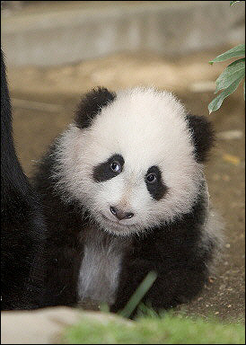|
Artificial insemination brings 21 panda cubs
By Liang Chao (China Daily)
Updated: 2006-01-02 07:28
Artificial insemination led to the successful birth of more pandas last year in China than ever before.

China celebrated the birthday of a giant panda who has outlived most of her peers by more than a decade, showering her with presents and even her own website. [AFP] |
A record 21 cubs survived from breeding programmes, according to the latest statistics released yesterday by the State Forestry Administration (SFA).
Sixteen of the newborn pandas are mainly living in the Wolong Giant Panda Breeding and Research Centre in the southwestern Sichuan Province, with the rest kept in captivity in other research institutions in Chengdu, provincial capital of Sichuan, Luoguantai in Northwest China's Shaanxi Province and Beijing Zoo.
To date, the number of giant pandas kept in captivity amounts to 183, with 54 per cent in Wolong, and about a quarter in Chengdu.
There are also 24 others kept in nine zoos in the United States, Japan, Germany, Austria and Thailand for research and other projects.
"Despite the early deaths of a few baby pandas, 2005 has witnessed the largest number of surviving newborn pandas in China's history of artificial fertilization on the rare species," said Na Chunfeng, an official with SFA.
Na attributed the achievement to Chinese scientists. "They have acquired mature technologies and valuable experience after years of hard work," he said.
Giant pandas show little instinctive behaviour in captivity, especially sexual desire, essential for natural mating and conception.
Forestry authority statistics show fewer than 10 per cent of male giant pandas mate naturally and fewer than 30 per cent of females conceive naturally.
Female pandas normally enter estrus aged four or five and have only one chance for pregnancy a year. After 160 days of pregnancy, they deliver only one or two cubs, according to Zhang Zhihe, head of the Chengdu-based Giant Panda Breeding Centre.
In the past 12 years, scientists at the Wolong centre have solved major problems relating to the breeding of giant pandas.
Zhang and his team have worked hard for years to tackle the endangered animals' breeding problems. Artificial fertilization led to the birth of nine cubs in 2000, 12 in 2001, 10 in 2002 and 15 in 2003. The number of giant pandas increased from 1,114 before 2000 to the present 1,596, living in habitats covering more than 23,000 square kilometres.
(China Daily 01/02/2006 page1)
|